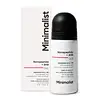What's inside
What's inside
 Key Ingredients
Key Ingredients

 Benefits
Benefits

 Concerns
Concerns

 Ingredients Side-by-side
Ingredients Side-by-side

Water
Skin Conditioning1,2-Hexanediol
Skin ConditioningMandelic Acid
AntimicrobialTriethyl Citrate
MaskingDimethyl Isosorbide
SolventPropanediol
SolventGlycolic Acid
BufferingEthoxydiglycol
HumectantHydrolyzed Wheat Protein
Skin ConditioningSalicylic Acid
Masking2-Methyl 5-Cyclohexylpentanol
Skin ConditioningDecylene Glycol
Skin ConditioningSodium PCA
HumectantPentylene Glycol
Skin ConditioningNonapeptide-1
Skin ConditioningHydroxyethylcellulose
Emulsion StabilisingSodium Hydroxide
BufferingPhenoxyethanol
PreservativeGlycyrrhiza Glabra Root Extract
BleachingEthylhexylglycerin
Skin ConditioningTrisodium Ethylenediamine Disuccinate
Water, 1,2-Hexanediol, Mandelic Acid, Triethyl Citrate, Dimethyl Isosorbide, Propanediol, Glycolic Acid, Ethoxydiglycol, Hydrolyzed Wheat Protein, Salicylic Acid, 2-Methyl 5-Cyclohexylpentanol, Decylene Glycol, Sodium PCA, Pentylene Glycol, Nonapeptide-1, Hydroxyethylcellulose, Sodium Hydroxide, Phenoxyethanol, Glycyrrhiza Glabra Root Extract, Ethylhexylglycerin, Trisodium Ethylenediamine Disuccinate
Water
Skin ConditioningPropylene Glycol
HumectantGlycerin
HumectantGlycolic Acid
BufferingAloe Barbadensis Leaf Extract
EmollientHamamelis Virginiana Extract
AntiseborrhoeicHydrogenated Castor Oil
EmollientNiacinamide
SmoothingHyaluronic Acid
HumectantGlutamic Acid
HumectantMandelic Acid
AntimicrobialUrea
BufferingPanthenol
Skin ConditioningSucrose
HumectantSorbitol
HumectantSqualene
EmollientAllantoin
Skin ConditioningKojic Acid
AntioxidantDipotassium Glycyrrhizate
HumectantCentella Asiatica Extract
CleansingParfum
MaskingEthylhexylglycerin
Skin ConditioningWater, Propylene Glycol, Glycerin, Glycolic Acid, Aloe Barbadensis Leaf Extract, Hamamelis Virginiana Extract, Hydrogenated Castor Oil, Niacinamide, Hyaluronic Acid, Glutamic Acid, Mandelic Acid, Urea, Panthenol, Sucrose, Sorbitol, Squalene, Allantoin, Kojic Acid, Dipotassium Glycyrrhizate, Centella Asiatica Extract, Parfum, Ethylhexylglycerin
 Reviews
Reviews

Ingredients Explained
These ingredients are found in both products.
Ingredients higher up in an ingredient list are typically present in a larger amount.
Ethylhexylglycerin (we can't pronounce this either) is commonly used as a preservative and skin softener. It is derived from glyceryl.
You might see Ethylhexylglycerin often paired with other preservatives such as phenoxyethanol. Ethylhexylglycerin has been found to increase the effectiveness of these other preservatives.
Glycolic Acid is arguably the most famous alpha hydroxy acid (AHA) with tons of research backing its benefits.
It is found naturally in sugar cane but the form used in skincare is usually synthetic for purity and stability.
Glycolic acid removes the top layer of dead skin cells to allow newer and fresher ones to emerge.
AHAs work by breaking down the structural “glue” that holds old skin cells in place. When that buildup is gone, your skin can renew itself more efficiently.
Research also shows glycolic acid stimulates collagen production, helping to firm and thicken the skin over time. This is one of its biggest advantages over other AHAs.
Overall, glycolic acid helps with:
Fun fact: Glycolic acid boosts skin hydration by helping it produce molecules that increase hyaluronic acid naturally.
To work best, glycolic acid products should have a pH between 3-4 (that’s where exfoliation is most effective but still gentle on skin).
The pH and concentration of a product are key to its effectiveness:
It is normal to feel a slight stinging sensation when using glycolic acid. This usually fades as your skin adjusts.
Because glycolic acid has the smallest molecular size in the AHA family, it can penetrate deeper, which enhances its effectiveness but also makes it more likely to irritate sensitive skin.
If your skin is very sensitive or prone to rosacea, glycolic acid may be too strong; in that case, try milder options like lactic acid or a PHA instead.
Recent studies suggest glycolic acid might even help protect against UV damage. But don’t skip sunscreen! Freshly exfoliated skin is more sensitive to the sun.
Glycolic acid is a skincare superstar. It smooths, brightens, hydrates, and firms the skin. Unless you’re highly sensitive, it’s well worth adding to your routine.
Read more about some other popular AHA's here:
Learn more about Glycolic AcidMandelic Acid is an alpha hydroxy acid (AHA).
Like other AHAs, it helps exfoliate the surface of the skin by breaking down the bonds that hold dead skin cells together. This helps reveal smoother and brighter skin underneath.
Mandelic acid helps with:
Due to it having a larger molecular size than glycolic acid, mandelic acid is able to penetrate the skin more slowly and evenly. This makes it gentler and less irritating, making it a great option for sensitive or beginner skin.
Despite being milder, mandelic acid is still an effective exfoliant that improves skin texture and tone over time.
What makes mandelic acid stand out from other AHAs? It has antibacterial and antioxidant properties.
These traits make it a great option for acne-prone or problem skin by reducing active breakouts and fading post-acne marks. Studies show that mandelic acid (especially when combined with salicylic acid) can significantly reduce pimples and hyperpigmentation while causing fewer side effects than stronger acids.
Mandelic acid is effective in concentrations of 5% and up with an ideal pH range of 3-4 for at-home use.
Like other AHAs, it’s important to wear sunscreen daily to protect your newly exfoliated skin.
However, unlike glycolic acid, mandelic acid is light-sensitive. Be sure your mandelic acid is packaged in opaque containers to ensure it stays stable and effective.
In short, mandelic acid is a gentle yet powerful AHA that exfoliates, brightens, and helps clarify skin while keeping irritation low. Its antibacterial action makes it especially beneficial for those with acne-prone, sensitive, or uneven skin, offering smoother, clearer, and more even-toned results over time.
Read more about some other popular AHA's here:
Learn more about Mandelic AcidWater. It's the most common cosmetic ingredient of all. You'll usually see it at the top of ingredient lists, meaning that it makes up the largest part of the product.
So why is it so popular? Water most often acts as a solvent - this means that it helps dissolve other ingredients into the formulation.
You'll also recognize water as that liquid we all need to stay alive. If you see this, drink a glass of water. Stay hydrated!
Learn more about Water